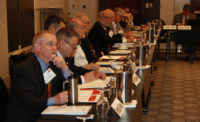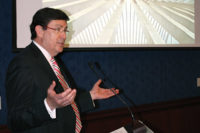WASHINGTON — In 2016, efficiency is more than a buzzword — it’s a target, a mandate, a highly desirable trait, and a profitable reality.
Global, national, and regional legislators are setting the pace by implementing policies and regulations that drastically cut energy waste and, as a result, are transitioning efficiency from a luxury to a commodity.
And, consumers are keeping stride. According to an annual Energy Pulse study from the Shelton Group, 85 percent of consumers said they’d pay more for an Energy Star-certified home than they would for extravagant features, including a pool, state-of-the-art sound system, or home theater room.
Pressed to remain one step ahead of all of these outside influences is the HVAC industry, which must carefully navigate government regulations and consumer expectations in hopes of providing applicable comfort systems equipped with cutting-edge, energy-conserving technologies.
And, while transformation in buildings has been brewing for decades, the new goals of policy — in the U.S. and around the world — will require much more coherence from every corner of the HVAC industry.
A group of more than 40 industry leaders met with that goal in mind, conducting a roundtable discussion focused on the role of government intervention, technological advances, infrastructure advancements, and more in the form of a roundtable during Danfoss’s 26th EnVisioneering Symposium — Tomorrow’s Buildings: New Driving Forces — June 7 in Washington, District of Columbia.
CLEAN POWER PLAN
Among the chief domestic efficiency propellants is the U.S. Clean Power Plan, which was announced by President Barack Obama Aug. 3, 2015. The plan sets state-by-state targets for carbon emissions reductions that may be met in numerous ways, including through investments in renewable energy and energy efficiency and creating separation from a reliance on coal-fired power. The plan offers a flexible framework as to when those targets may be met.
Six months after its introduction, the plan was put on pause as the U.S. Supreme Court issued a hold that will stay in place until a lower court rules on the merits or the Supreme Court either refuses to hear the case or offers a ruling. This suspension is likely to last for approximately 18 months, depending upon how quickly the appellate process proceeds.
Julie Rosenberg, branch chief, state and local climate and energy programs, U.S. Environmental Protection Agency (EPA), opened the EnVisioneering Symposium by expressing her support for the plan.
“Despite the Supreme Court’s action, the main takeaway is to stay positive,” Rosenberg said. “We’re incredibly excited where we are with the momentum on energy efficiency, clean energy, and climate action, and while the Clean Power Plan doesn’t change the world, it does capture a great deal of momentum [regarding energy efficiency] and locks that in.”
Rosenberg was joined by Cindy Jacobs, senior advisor, commercial and industrial buildings branch, climate protection partnership division, office of air and radiation, EPA, who reminded attendees the cheapest kilowatt hour of energy is the one that isn’t used.
“Efficiency is a critical piece [of the puzzle] when it comes to reducing greenhouse gases globally,” Jacobs said. “In terms of emissions, the most recent greenhouse gas inventory states that commercial buildings account for 17 percent of electricity and emissions. This Clean Power Plan offers cost savings and reduces emissions.”
Boima Morray, vice president of marketing, Danfoss Drives America, said such policies are necessary to unlock the energy-saving technologies of the future.
“From a manufacturer standpoint, we have control over engineering high-efficiency products and technologies, such as controls, fans, pumps, compressors, electric motors, and more. We have the know-how to get there,” he said. “However, the right regulations and standards have to be there, and it’s important that regulatory bodies work together and with the industry.”
During the Supreme Court’s stay, Rosenberg said the EPA is not actively reaching out to stakeholders regarding their efficiency endeavors, though staff is available to answer questions and offer suggestions.
“There are other rules the EPA is considering, and we’re always looking at ways to use efficiency within specific policies to meet emissions goals,” she said. “In the end, the juice will be worth the squeeze, because the EPA takes efficiency very seriously.”
SYSTEMS EFFICIENCY INITIATIVE
Laura Van Wie McGrory, vice president for international policy, Alliance to Save Energy (ASE), introduced the organization’s Systems Efficiency Initiative (SEI) during the event’s second session, which focused on research and how municipalities are driving innovation.
The SEI is an effort that has brought more than 50 industry stakeholders — including manufacturers, designers and builders, electric and natural gas utilities, building owners, and efficiency advocates — together to focus on defining ways to achieve the next level of efficiency in buildings by optimizing building systems.
The purpose of the initiative is to:
• Compile and build on research and lessons learned about systems efficiency by the U.S. building industry and in other countries;
• Educate the market about the increased economic and environmental benefits of taking into account building system opportunities and interactions; and
• Identify the tools — including research needs, policies, programs, investments and incentives — needed to transform the market.
SEI partners aim to build a consensus definition for a systems approach, which will allow them to better understand and share information about the opportunities for systems-level energy efficiency in buildings. The group also recommends near- and longer-term policies and actions to accelerate system efficiency that builds on the lessons learned from more than three decades of addressing component and whole-building efficiency.
Van Wie McGrory said many current mechanical system tools and assumptions are inaccurate when it comes to predicting HVAC system performance under varying conditions.
“Metrics need to be based on annual energy use with appropriate inputs for variable weather and building loads,” she said. “An effective systems approach includes commissioning, monitoring, reporting, and maintenance.”
To advance these concerns, she reported the SEI has suggested the need to develop new industrywide systems-level metrics.
“These metrics will offer better modeling to reflect real-world conditions, analyze mechanical systems at full and partial loads, and establish better baselines,” she said.
Additionally, the SEI has suggested greater coordination with ASHRAE 90.1 and advanced energy standards committees including Air-Conditioning, Heating, and Refrigeration Institute’s (AHRI’s) Steering Committee. Further suggestions included facilitating an ongoing conversation amongst key industry stakeholders and enhanced workforce training on systems approaches.
The ASE introduced a Year 1 report of the SEI — “Greater Than the Sum of its Parts: The Case for a Systems Approach to Energy Efficiency,” at the Energy Efficiency Global Forum, May 11. To see the complete report, visit www.ase.org/sei.
THE ROLE OF THE IOT
Event moderator, Robert Cavey, partner, Praxis, asked, “Is it likely the Internet of Things will have a major influence on efficiency, and is that influence likely to occur within the next 10 years?”
Jason Hartke, program manager, commercial buildings integration, U.S. Department of Energy (DOE), responded by saying, when it comes to buildings, progress starts and stops with data.
“How do we get more access to data? Perhaps that happens via policies that require building owners to disclose their energy usage,” he said. “We’re seeing an infusion of new data, and I believe this data will drive additional efficiency opportunities in the future. I’m not sure about the exact timeframe, though 10 years from now, I believe we’ll be a lot further ahead than where we are today.”
Maureen Guttman, president, Building Codes Assistance Project, said the demand for whole-building data simply isn’t great at this point in time.
“That lack of demand may be due to a lack of data,” she said. “A lot more data are necessary to help businesses make wise economic decisions. People are making decisions based on first cost and will continue to do so until we can present applicable data and say, ‘Look, this is what’s going on, and here are the data to prove it.’”
For more information on Danfoss’s EnVisioneering Symposium Series, visit www.danfoss.com.
Publication date: 8/15/2016
Want more HVAC industry news and information? Join The NEWS on Facebook, Twitter, and LinkedIn today!







